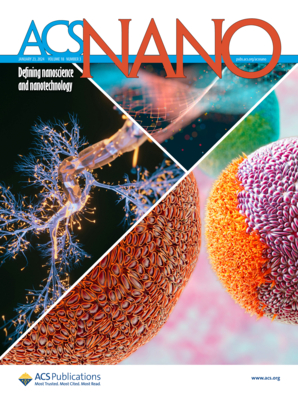A Nitroreductase-Responsive Type I Photosensitizer with Aggregation-Induced Emission Characteristics for Precise Hypoxic Cancer Theranostics.
IF 15.8
1区 材料科学
Q1 CHEMISTRY, MULTIDISCIPLINARY
引用次数: 0
Abstract
Cancer remains a significant global health challenge, with early and accurate detection being key to improving treatment outcomes. Developing targeted photosensitizers (PS) that selectively image and treat cancer cells is critical for cancer diagnosis, staging, and treatment monitoring. Understanding the hypoxic nature of solid tumors is essential in cancer detection, as hypoxia is associated with tumor aggressiveness and therapy resistance. Nitroreductase (NTR), which is overexpressed in hypoxic tumors, offers a target for selective imaging and treatment. In this study, we developed a type-I PS called TPAPyN, which is responsive to NTR. TPAPyN facilitates the imaging of hypoxic cancer cells and facilitates image-guided photodynamic therapy (PDT). Because of photoinduced electron transfer, TPAPyN does not emit fluorescence in the aqueous environment. However, its fluorescence is restored when NTR cleaves the nitrofuran quencher, forming highly emissive TPAPy aggregates. This characteristic makes TPAPyN a valuable fluorescent probe for specific imaging of NTR-overexpressed cancer cells. Additionally, TPAPy exhibits high efficiency in generating reactive oxygen species, indicating its potential as a PS for cancer treatment via PDT.一种具有聚集诱导发射特性的硝基还原酶反应型光敏剂用于精确缺氧癌症治疗。
癌症仍然是一项重大的全球健康挑战,早期和准确的检测是改善治疗结果的关键。开发选择性成像和治疗癌细胞的靶向光敏剂(PS)对癌症诊断、分期和治疗监测至关重要。了解实体肿瘤的缺氧特性对癌症检测至关重要,因为缺氧与肿瘤的侵袭性和治疗抵抗有关。硝基还原酶(NTR)在缺氧肿瘤中过表达,为选择性成像和治疗提供了靶点。在这项研究中,我们开发了一种名为TPAPyN的i型PS,它对NTR有反应。TPAPyN促进缺氧癌细胞的成像,促进图像引导光动力治疗(PDT)。由于光致电子转移,TPAPyN在水环境中不发出荧光。然而,当NTR裂解硝基呋喃猝灭剂时,其荧光恢复,形成高发射的TPAPy聚集体。这一特性使TPAPyN成为一种有价值的荧光探针,用于特异性成像ntr过表达的癌细胞。此外,TPAPy在产生活性氧方面表现出高效率,这表明它有潜力作为一种通过PDT治疗癌症的PS。
本文章由计算机程序翻译,如有差异,请以英文原文为准。
求助全文
约1分钟内获得全文
求助全文
来源期刊

ACS Nano
工程技术-材料科学:综合
CiteScore
26.00
自引率
4.10%
发文量
1627
审稿时长
1.7 months
期刊介绍:
ACS Nano, published monthly, serves as an international forum for comprehensive articles on nanoscience and nanotechnology research at the intersections of chemistry, biology, materials science, physics, and engineering. The journal fosters communication among scientists in these communities, facilitating collaboration, new research opportunities, and advancements through discoveries. ACS Nano covers synthesis, assembly, characterization, theory, and simulation of nanostructures, nanobiotechnology, nanofabrication, methods and tools for nanoscience and nanotechnology, and self- and directed-assembly. Alongside original research articles, it offers thorough reviews, perspectives on cutting-edge research, and discussions envisioning the future of nanoscience and nanotechnology.
 求助内容:
求助内容: 应助结果提醒方式:
应助结果提醒方式:


